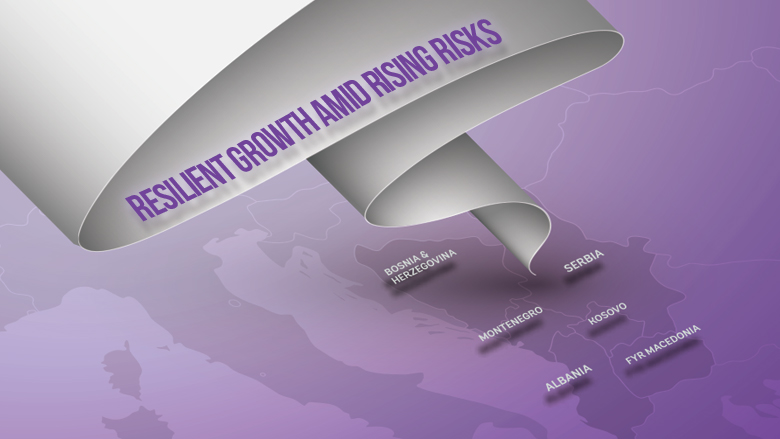Download full report: South East Europe Regular Economic Report No. 10
The six countries of South East Europe (SEE6)—Albania, Bosnia and Herzegovina (BiH), Kosovo, FYR Macedonia, Montenegro, and Serbia—must operate within a complicated global environment. Political, institutional, and policy uncertainty in advanced economies, still low commodity prices, and exceptionally low interest rates dampen global growth expectations. Growth is slow everywhere, and the European Union (EU), a major destination for SEE6 exports, this year is estimated to grow 1.9 percent, even less than last year’s 2 percent. In Europe, uncertainty has been heightened by the referendum decision in the United Kingdom to exit the EU, the ongoing crisis in Greece, pressures on Italian banks, political tensions in Turkey, and the continuing refugee crisis. Brexit has renewed the debate about the future of the EU and the potential impact on states that are on the path to accession. But SEE6 countries continue to pursue firmly their aspirations for integration with the EU, with several countries this year having opened new chapters.
Despite the external context, growth in SEE6 is firming up. We project growth to strengthen from 2.2 percent in 2015 to 2.7 percent in 2016, driven by robust investment and recovering household consumption. The regional expansion reflects the recovery of growth primarily in Serbia, and also in Albania (Table A). Investment continues to drive growth, especially in Albania, Montenegro, and Serbia. After several years of moderation, consumption also accelerated, mainly fueled by improvements in labor markets (Albania, Kosovo, and Serbia) and higher public wages and transfers (FYR Macedonia and Montenegro).
Resilient economic growth and labor market reforms continue to support private sector job creation. Combined with stronger economic growth, reduced labor market rigidities resulted in employment growth of 4.7 percent in Serbia in the first half of 2016. Formalization efforts contributed to 6.7 percent employment growth in Albania. However, despite recent improvements, employment is still below precrisis levels in all SEE6 countries except FYR Macedonia and Montenegro. Unemployment continued to decline in most countries except Montenegro, where it grew in part due to recent public policy choices. However, the regional average remains high at about 25 percent.
Risks to the near-term outlook of SEE6 are on the downside, with external positions especially vulnerable. In 2016, the region’s current account deficit (CAD) is expected to hold at 6.4 percent of GDP, higher than in 2015 as the narrower deficit in Serbia is offset by wider deficits in its neighbors. Larger trade deficits, falling remittances, and dividend payments to nonresident investors are driving this dynamic for Albania, Montenegro, and Kosovo. Lower income inflows and remittances explain the wider CADs of Bosnia and Herzegovina (BiH) and FYR Macedonia. After surging in 2015, net inflows of foreign direct investment (FDI) declined as a share of GDP in 2016 but continue to finance a large proportion of the CADs. Portfolio flows declined for several consecutive periods, reflecting negative developments in international markets.
Countries that persisted with fiscal consolidation efforts stabilized their public and publicly guaranteed (PPG) debt for the first time since the global crisis began. Fiscal consolidations started to bear fruit, helping reduce the region’s average fiscal deficit from 3.6 percent of GDP in 2015 to 3.4 percent in 2016. These results were driven by Albania, BiH, and Serbia that continue their fiscal consolidation efforts and are expected to record low or declining fiscal deficits this year and declining public and publicly guaranteed (PPG) debt for the first time since 2009. In contrast, fiscal positions are likely to worsen in Kosovo, FYR Macedonia, and Montenegro, leading to larger PPG debts.
In most SEE countries lending to the private sector is slowly recovering. Credit growth has rebounded in Serbia as economic activity geared up. Similarly, new lending has grown in Albania, particularly for consumption, and Kosovo, pushed by lower lending rates. Credit growth stayed positive in FYR Macedonia and Kosovo, although eroding confidence affected corporate lending in the first part of 2016. Credit growth has been weaker in Montenegro because of low credit demand from the corporate segment; and supply conditions in BiH also kept credit growth down. Although banks in the region are profitable, liquid, and well-capitalized, non-performing loans (NPLs) are still higher than they were before the crisis.
Near-term growth prospects for the SEE6 are positive, but the risks highlight the importance of structural reforms for successful rebalancing from domestic to external sources of growth. Growth in the region is forecast to rise from 2.7 percent in 2016 to 3.6 percent in 2018 because of greater domestic demand—investment with support from consumption—as well as recovering exports. However, economic growth prospects in the EU, and other uncertainties in the region will continue to weigh on growth projections in the SEE6. With most countries either emerging from or entering the election cycle, political uncertainty is exacerbating the risks, although the beginning of a new political cycle provides an opportunity to advance structural reforms. Issues that are constraining SEE6 potential growth are the stubbornly high unemployment, weak business and governance environment, inferior delivery of public services, and shallow global integration.

